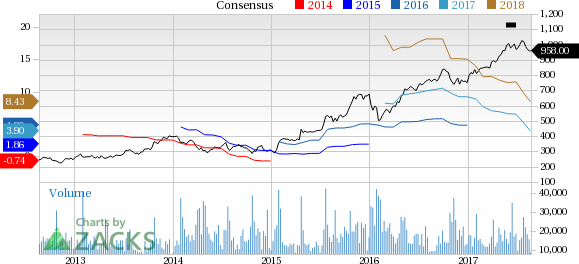Amazon.com, Inc.’s (NASDAQ:AMZN) much-awaited acquisition of Whole Foods Market, Inc. (NASDAQ:WFM) has overcome two of its biggest hurdles.
The pending deal has been granted an antitrust clearance by the Federal Trade Commission (FTC). Notably, FTC does not expect the deal to hurt competition in any way, and has thus given a nod to the deal. Also, the Whole Foods Market shareholders have approved the buyout.
Importantly, these were the last approvals required to complete the merger. Subject to the remaining customary closing conditions, both the companies expect the transaction to close by the end of this year.
Amazon has underperformed the industry on a year-to-date basis. The company’s shares have gained only 27.8%, lower than the industry’s gain of 50.3%.

Details
In June, Amazon inked a definitive merger to purchase a leading natural and organic foods supermarket, Whole Foods Market for $13.7 billion. The all-cash transaction involves buying Whole Foods for $42 per share.
The company recently announced a private offering of bonds aggregating $16 billion to fund its acquisition of Whole Foods Market, Inc.
On completion, Whole Foods will continue to operate with its current brand name and John Mackey will remain the CEO of the company. Amazon could likely become the fifth largest United States grocery retailer after Wal-Mart (NYSE:WMT) , Kroger (NYSE:KR) , Costco (NASDAQ:COST) and Albertsons/Safeway.
The deal gives Amazon an opportunity to leverage Whole Foods’ 460 stores across the United States, the United Kingdom and Canada, 87,000 employees, and its solid reputation.
Deal Rationale
The deal will open a window of opportunities for Amazon in the retail market. Online retail sales are expected to decelerate, while the overall retail market still holds a lot of potential. This might be because a large number of customers still prefer shopping offline and will continue to do so in the future. This is particularly true when it comes to grocery.
Therefore, Amazon has been making moves to gradually merge online and offline retail.
Amazon might add a few new offline and online features to Whole Foods’ stores in the future. The deal gives Amazon opportunities to leverage its resources and technological prowess to enhance shopping experience by cutting time and increasing convenience. This in turn could give it an edge over competing retailers.
We believe that the acquisition will not only reshape the retail landscape but also help it counter competition, if it manages to get a first mover advantage.
Bottom Line
In the face of slow e-commerce growth and mounting competition, Amazon is looking for ways to branch out to physical retail, a sizable brick-and-mortar footprint.
So Amazon’s increasing transition from build-to-buy option is a clear indication of the company wanting to speed up its market penetration, expansion and competitive strategies.
Although brick-and-mortar initiatives are relatively new, investors will see far more growth if Amazon could repeat its past success in this space. Everything that Amazon touches has been transformed to gold and its brick-and-mortar venture could well add another feather in its cap.
Zacks Rank
Currently, Amazon has a Zacks Rank 3 (Hold). You can see the complete list of today’s Zacks #1 Rank stocks here.
One Simple Trading Idea
Since 1988, the Zacks system has more than doubled the S&P 500 with an average gain of +25% per year. With compounding, rebalancing, and exclusive of fees, it can turn thousands into millions of dollars.
This proven stock-picking system is grounded on a single big idea that can be fortune shaping and life changing. You can apply it to your portfolio starting today.
Amazon.com, Inc. (AMZN): Free Stock Analysis Report
Wal-Mart Stores, Inc. (WMT): Free Stock Analysis Report
Kroger Company (The) (KR): Free Stock Analysis Report
Whole Foods Market, Inc. (WFM): Free Stock Analysis Report
Original post
Zacks Investment Research

